Using PyMC3¶
PyMC3 is a Python package for doing MCMC using a variety of samplers, including Metropolis, Slice and Hamiltonian Monte Carlo. See Probabilistic Programming in Python using PyMC for a description. The GitHub site also has many examples and links for further exploration.
Installation
! pip install --process-dependency-links git+https://github.com/pymc-devs/pymc3
Other resources
Some examples are adapted from:
In [1]:
import pymc3 as pm
import numpy.random as rng
import scipy.stats as stats
from sklearn.preprocessing import StandardScaler
Coin bias¶
We start with the simplest model - that of determining the bias of a coin from observed outcomes.
Setting up the model¶
In [2]:
n = 100
heads = 61
Anaalytical solution¶
In [3]:
a, b = 10, 10
prior = stats.beta(a, b)
post = stats.beta(heads+a, n-heads+b)
ci = post.interval(0.95)
xs = np.linspace(0, 1, 100)
plt.plot(prior.pdf(xs), label='Prior')
plt.plot(post.pdf(xs), label='Posterior')
plt.axvline(100*heads/n, c='red', alpha=0.4, label='MLE')
plt.xlim([0, 100])
plt.axhline(0.3, ci[0], ci[1], c='black', linewidth=2, label='95% CI');
plt.legend()
pass

Introduction to PyMC3¶
In [4]:
niter = 2000
with pm.Model() as coin_context:
p = pm.Beta('p', alpha=2, beta=2)
y = pm.Binomial('y', n=n, p=p, observed=heads)
trace = pm.sample(niter)
Applied logodds-transform to p and added transformed p_logodds to model.
Assigned NUTS to p_logodds
[-----------------100%-----------------] 2000 of 2000 complete in 0.8 sec
Specifying start, sampler (step) and multiple chains¶
In [5]:
with coin_context:
start = pm.find_MAP()
step = pm.Metropolis()
trace = pm.sample(niter, step=step, start=start, njobs=4, random_seed=123)
[-----------------100%-----------------] 2000 of 2000 complete in 0.4 sec
Summary of results¶
Getting values from the trace¶
In [8]:
p = trace.get_values('p', burn=niter//2, combine=True, chains=[0,2])
p.shape
Out[8]:
(2000,)
Calculate effective sample size¶
where \(m\) is the number of chains, \(n\) the number of steps per chain, \(T\) the time when the autocorrelation first becomes negative, and \(\hat{\rho}_t\) the autocorrelation at lag \(t\).
In [10]:
pm.effective_n(t)
Out[10]:
{'p': 767, 'p_logodds': 765}
Evaluate convergence¶
Gelman-Rubin¶
where \(W\) is the within-chain variance and \(\hat{V}\) is the posterior variance estimate for the pooled traces. Values greater than one indicate that one or more chains have not yet converged.
Discrad burn-in steps for each chain. The idea is to see if the starting values of each chain come from the same distribution as the stationary state.
- \(W\) is the number of chains \(m \times\) the variacne of each individual chain
- \(B\) is the number of steps \(n \times\) the variance of the chain means
- \(\hat{V}\) is the weigthed average \((1 - \frac{1}{n})W + \frac{1}{n}B\)
The idea is that \(\hat{V}\) is an unbiased estimator of \(W\) if the starting values of each chain come from the same distribution as the stationary state. Hence if \(\hat{R}\) differs significantly from 1, there is probsbly no convergence and we need more iterations. This is done for each parameter \(\theta\).
In [11]:
pm.gelman_rubin(t)
Out[11]:
{'p': 0.99949987493746095, 'p_logodds': 0.99949987493746095}
Geweke¶
Compares mean of initial with later segments of a trace for a parameter. Should have absolute value less than 1 at convergence.
In [12]:
plt.plot(pm.geweke(t['p'])[:,1], 'o')
plt.axhline(1, c='red')
plt.axhline(-1, c='red')
plt.gca().margins(0.05)
pass
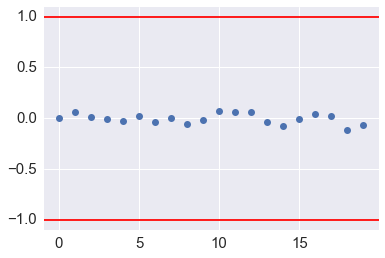
Textual summary¶
In [13]:
pm.summary(t, varnames=['p'])
p:
Mean SD MC Error 95% HPD interval
-------------------------------------------------------------------
0.615 0.050 0.002 [0.517, 0.698]
Posterior quantiles:
2.5 25 50 75 97.5
|--------------|==============|==============|--------------|
0.517 0.581 0.616 0.654 0.698
Posterior predictive samples¶
In [15]:
with coin_context:
ppc = pm.sample_ppc(t, samples=100)
ppc['y'].ravel()
Out[15]:
array([73, 76, 58, 65, 59, 61, 72, 66, 59, 60, 51, 61, 69, 68, 68, 64, 66,
56, 70, 63, 63, 73, 49, 56, 52, 59, 55, 55, 63, 56, 66, 55, 61, 59,
64, 63, 68, 49, 58, 57, 55, 59, 69, 62, 65, 51, 73, 61, 67, 62, 51,
51, 59, 51, 64, 58, 67, 64, 58, 68, 64, 63, 68, 69, 70, 71, 66, 68,
58, 57, 66, 48, 63, 67, 57, 60, 65, 64, 56, 62, 55, 56, 56, 58, 62,
59, 69, 53, 50, 67, 58, 63, 57, 64, 62, 72, 73, 66, 67, 70])
Saving traces¶
In [16]:
from pymc3.backends import Text
niter = 2000
with pm.Model() as text_save_demo:
p = pm.Beta('p', alpha=2, beta=2)
y = pm.Binomial('y', n=n, p=p, observed=heads)
db = Text('trace')
trace = pm.sample(niter, trace=db)
Applied logodds-transform to p and added transformed p_logodds to model.
Assigned NUTS to p_logodds
[-----------------100%-----------------] 2000 of 2000 complete in 0.8 sec
In [17]:
with text_save_demo:
trace = pm.backends.text.load('trace')
pm.traceplot(trace, varnames=['p'])

If you are fitting a large complex model that may not fit in memory, you can use the SQLite3 backend to save the trace incremnetally to disk.
In [18]:
from pymc3.backends import SQLite
niter = 2000
with pm.Model() as sqlie3_save_demo:
p = pm.Beta('p', alpha=2, beta=2)
y = pm.Binomial('y', n=n, p=p, observed=heads)
db = SQLite('trace.db')
trace = pm.sample(niter, trace=db)
Applied logodds-transform to p and added transformed p_logodds to model.
Assigned NUTS to p_logodds
[-----------------100%-----------------] 2000 of 2000 complete in 0.8 sec
In [19]:
with sqlie3_save_demo:
trace = pm.backends.sqlite.load('trace.db')
pm.traceplot(trace, varnames=['p'])

Sampling from prior¶
Just omit the observed= argument.
In [20]:
with pm.Model() as prior_context:
sigma = pm.Gamma('gamma', alpha=2.0, beta=1.0)
mu = pm.Normal('mu', mu=0, sd=sigma)
trace = pm.sample(niter, step=pm.Metropolis())
Applied log-transform to gamma and added transformed gamma_log to model.
[-----------------100%-----------------] 2000 of 2000 complete in 0.5 sec
Univariate normal distribution¶
In [21]:
xs = rng.normal(loc=5, scale=2, size=100)
In [22]:
sns.distplot(xs, rug=True)
pass
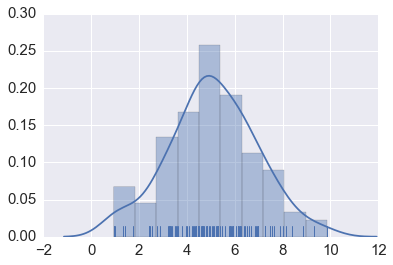
In [23]:
pm.traceplot(trace, varnames=['mu'])
pass

Sampling from posterior¶
In [24]:
niter = 2000
with pm.Model() as normal_context:
mu = pm.Normal('mu', mu=0, sd=100)
sd = pm.HalfCauchy('sd', beta=2)
y = pm.Normal('y', mu=mu, sd=sd, observed=xs)
start = pm.find_MAP()
step = pm.NUTS(scaling=start)
trace = pm.sample(niter, start=start, step=step)
Applied log-transform to sd and added transformed sd_log to model.
[-----------------100%-----------------] 2000 of 2000 complete in 1.2 sec
In [25]:
pm.traceplot(trace, varnames=['mu', 'sd'])
pass

Linear regression¶
We will show how to estimate regression parameters using a simple linear model
We can restate the linear model
as sampling from a probability distribution
Now we can use pymc to estimate the parameters \(a\), \(b\)
and \(\sigma\). We will assume the following priors
In [26]:
# observed data
np.random.seed(123)
n = 11
_a = 6
_b = 2
x = np.linspace(0, 1, n)
y = _a*x + _b + np.random.randn(n)
In [27]:
niter = 10000
with pm.Model() as linreg:
a = pm.Normal('a', mu=0, sd=100)
b = pm.Normal('b', mu=0, sd=100)
sigma = pm.HalfNormal('sigma', sd=1)
y_est = a*x + b
likelihood = pm.Normal('y', mu=y_est, sd=sigma, observed=y)
start = pm.find_MAP()
step = pm.NUTS(scaling=start)
trace = pm.sample(niter, step, start, random_seed=123)
Applied log-transform to sigma and added transformed sigma_log to model.
[-----------------100%-----------------] 10000 of 10000 complete in 10.7 sec
In [28]:
t = trace[niter//2:]
pm.traceplot(trace, varnames=['a', 'b'])
pass

In [29]:
plt.scatter(x, y, s=30, label='data')
for a_, b_ in zip(t['a'][-100:], t['b'][-100:]):
plt.plot(x, a_*x + b_, c='gray', alpha=0.1)
plt.plot(x, _a*x + _b, label='true regression line', lw=3., c='red')
plt.legend(loc='best')
pass
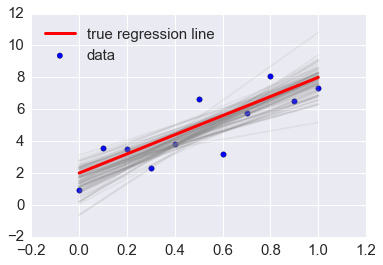
Using the GLM module¶
In [30]:
df = DataFrame({'x': x, 'y': y})
df.head()
Out[30]:
| x | y | |
|---|---|---|
| 0 | 0.0 | 0.914369 |
| 1 | 0.1 | 3.597345 |
| 2 | 0.2 | 3.482978 |
| 3 | 0.3 | 2.293705 |
| 4 | 0.4 | 3.821400 |
In [31]:
with pm.Model() as model:
pm.glm.glm('y ~ x', df)
start = pm.find_MAP()
step = pm.NUTS(scaling=start)
trace = pm.sample(2000, start=start, step=step)
Applied log-transform to sd and added transformed sd_log to model.
[-----------------100%-----------------] 2000 of 2000 complete in 2.9 sec
In [32]:
pm.traceplot(trace, varnames=['Intercept', 'x'])
pass

Robust linear regression¶
In [33]:
# observed data
np.random.seed(123)
n = 11
_a = 6
_b = 2
x = np.linspace(0, 1, n)
y = _a*x + _b + np.random.randn(n)
y[5] *=10
df = DataFrame({'x': x, 'y': y})
df.head()
Out[33]:
| x | y | |
|---|---|---|
| 0 | 0.0 | 0.914369 |
| 1 | 0.1 | 3.597345 |
| 2 | 0.2 | 3.482978 |
| 3 | 0.3 | 2.293705 |
| 4 | 0.4 | 3.821400 |
In [34]:
x, y = StandardScaler().fit_transform(df[['x', 'y']]).T
In [35]:
niter = 10000
with pm.Model() as linreg:
a = pm.Normal('a', mu=0, sd=100)
b = pm.Normal('b', mu=0, sd=100)
sigma = pm.HalfNormal('sigma', sd=1)
y_est = a*x + b
y_obs = pm.Normal('y_obs', mu=y_est, sd=sigma, observed=y)
start = pm.find_MAP()
step = pm.NUTS(scaling=start)
trace = pm.sample(niter, step, start, random_seed=123)
Applied log-transform to sigma and added transformed sigma_log to model.
[-----------------100%-----------------] 10000 of 10000 complete in 7.7 sec
In [36]:
t = trace[niter//2:]
plt.scatter(x, y, s=30, label='data')
for a_, b_ in zip(t['a'][-100:], t['b'][-100:]):
plt.plot(x, a_*x + b_, c='gray', alpha=0.1)
plt.legend(loc='upper left')
pass
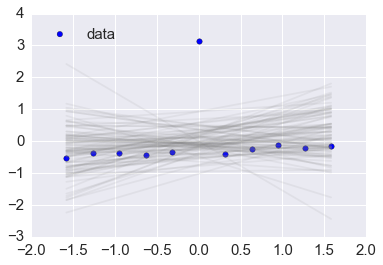
In [37]:
niter = 10000
with pm.Model() as robust_linreg:
beta = pm.Normal('beta', 0, 10, shape=2)
nu = pm.Exponential('nu', 1/len(x))
sigma = pm.HalfCauchy('sigma', beta=1)
y_est = beta[0] + beta[1]*x
y_obs = pm.StudentT('y_obs', mu=y_est, sd=sigma, nu=nu, observed=y)
start = pm.find_MAP()
step = pm.NUTS(scaling=start)
trace = pm.sample(niter, step, start, random_seed=123)
Applied log-transform to nu and added transformed nu_log to model.
Applied log-transform to sigma and added transformed sigma_log to model.
[-----------------100%-----------------] 10000 of 10000 complete in 15.1 sec
In [38]:
t = trace[niter//2:]
plt.scatter(x, y, s=30, label='data')
for a_, b_ in zip(t['beta'][-100:, 1], t['beta'][-100:, 0]):
plt.plot(x, a_*x + b_, c='gray', alpha=0.1)
plt.legend(loc='upper left')
pass
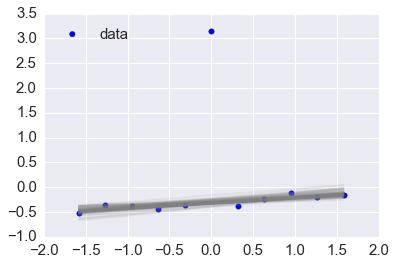
Logistic regression¶
We will look at the effect of strongly correlated variabels using a data set from Kruschke’s book.
In [39]:
df = pd.read_csv('HtWt.csv')
df.head()
Out[39]:
| male | height | weight | |
|---|---|---|---|
| 0 | 0 | 63.2 | 168.7 |
| 1 | 0 | 68.7 | 169.8 |
| 2 | 0 | 64.8 | 176.6 |
| 3 | 0 | 67.9 | 246.8 |
| 4 | 1 | 68.9 | 151.6 |
In [40]:
niter = 1000
with pm.Model() as model:
pm.glm.glm('male ~ height + weight', df, family=pm.glm.families.Binomial())
start = pm.find_MAP()
step = pm.Slice()
trace = pm.sample(niter, start=start, step=step, njobs=4, random_seed=123)
Applied logodds-transform to p and added transformed p_logodds to model.
[-----------------100%-----------------] 1000 of 1000 complete in 21.1 sec
In [41]:
df_trace = pm.trace_to_dataframe(trace[niter//2:])
pd.scatter_matrix(df_trace.ix[-niter//2:, ['height', 'weight', 'Intercept']], diagonal='kde')
plt.tight_layout()
pass
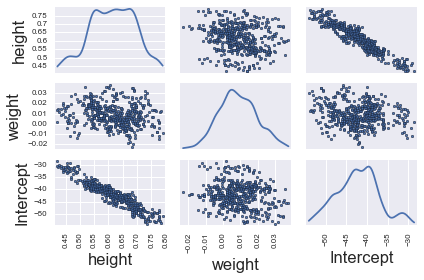
In [42]:
niter = 1000
with pm.Model() as model:
pm.glm.glm('male ~ height + weight', df, family=pm.glm.families.Binomial())
start = pm.find_MAP()
step = pm.NUTS(scaling=start)
trace = pm.sample(niter, start=start, step=step, njobs=4, random_seed=123)
Applied logodds-transform to p and added transformed p_logodds to model.
[-----------------100%-----------------] 1000 of 1000 complete in 13.0 sec
In [43]:
df_trace = pm.trace_to_dataframe(trace[niter//2:])
pd.scatter_matrix(df_trace.ix[-niter//2:, ['height', 'weight', 'Intercept']], diagonal='kde')
plt.tight_layout()
pass
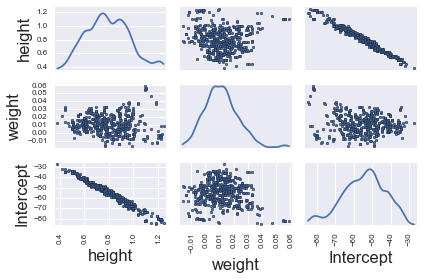
Logistic regression for classification¶
In [44]:
height, weight, intercept = df_trace[['height', 'weight', 'Intercept']].mean(0)
def predict(w, h, intercept=intercept, height=height, weight=weight):
"""Predict gender given weight (w) and height (h) values."""
v = intercept + height*h + weight*w
return np.exp(v)/(1+np.exp(v))
# calculate predictions on grid
xs = np.linspace(df.weight.min(), df.weight.max(), 100)
ys = np.linspace(df.height.min(), df.height.max(), 100)
X, Y = np.meshgrid(xs, ys)
Z = predict(X, Y)
plt.figure(figsize=(6,6))
# plot 0.5 contour line - classify as male if above this line
plt.contour(X, Y, Z, levels=[0.5])
# classify all subjects
colors = ['lime' if i else 'yellow' for i in df.male]
ps = predict(df.weight, df.height)
errs = ((ps < 0.5) & df.male) |((ps >= 0.5) & (1-df.male))
plt.scatter(df.weight[errs], df.height[errs], facecolors='red', s=150)
plt.scatter(df.weight, df.height, facecolors=colors, edgecolors='k', s=50, alpha=1);
plt.xlabel('Weight', fontsize=16)
plt.ylabel('Height', fontsize=16)
plt.title('Gender classification by weight and height', fontsize=16)
plt.tight_layout();
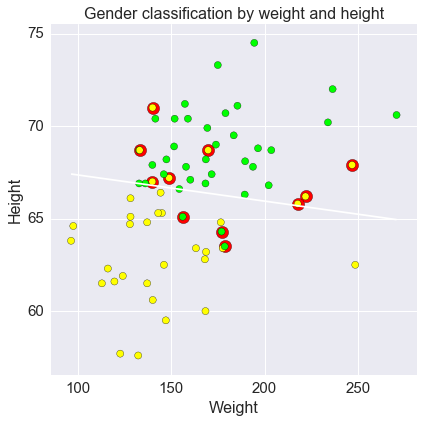
Estimating parameters of a logistic model¶
Gelman’s book has an example where the dose of a drug may be affected to the number of rat deaths in an experiment.
| Dose (log g/ml) | # Rats | # Deaths |
|---|---|---|
| -0.896 | 5 | 0 |
| -0.296 | 5 | 1 |
| -0.053 | 5 | 3 |
| 0.727 | 5 | 5 |
We will model the number of deaths as a random sample from a binomial distribution, where \(n\) is the number of rats and \(p\) the probability of a rat dying. We are given \(n = 5\), but we believe that \(p\) may be related to the drug dose \(x\). As \(x\) increases the number of rats dying seems to increase, and since \(p\) is a probability, we use the following model:
where we set vague priors for \(\alpha\) and \(\beta\), the parameters for the logistic model.
In [45]:
n = 5 * np.ones(4)
x = np.array([-0.896, -0.296, -0.053, 0.727])
y = np.array([0, 1, 3, 5])
In [46]:
def invlogit(x):
return pm.exp(x) / (1 + pm.exp(x))
with pm.Model() as model:
alpha = pm.Normal('alpha', mu=0, sd=5)
beta = pm.Flat('beta')
p = invlogit(alpha + beta*x)
y_obs = pm.Binomial('y_obs', n=n, p=p, observed=y)
start = pm.find_MAP()
step = pm.NUTS()
trace = pm.sample(niter, step, start, random_seed=123)
[-----------------100%-----------------] 1000 of 1000 complete in 1.1 sec
In [47]:
f = lambda a, b, xp: np.exp(a + b*xp)/(1 + np.exp(a + b*xp))
xp = np.linspace(-1, 1, 100)
a = trace.get_values('alpha').mean()
b = trace.get_values('beta').mean()
plt.plot(xp, f(a, b, xp), c='red')
plt.scatter(x, y/5, s=50);
plt.xlabel('Log does of drug')
plt.ylabel('Risk of death')
pass
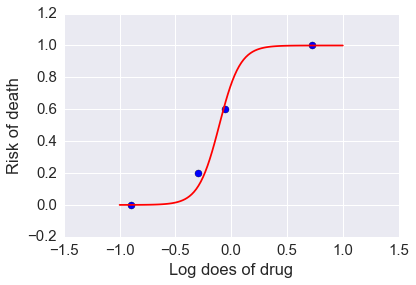
Hierarchical model¶
This uses the Gelman radon data set and is based off this IPython notebook. Radon levels were measured in houses from all counties in several states. Here we want to know if the presence of a basement affects the level of radon, and if this is affected by which county the house is located in.
The data set provided is just for the state of Minnesota, which has 85
counties with 2 to 116 measurements per county. We only need 3 columns
for this example county, log_radon, floor, where floor=0
indicates that there is a basement.
We will perform simple linear regression on log_radon as a function of county and floor.
In [48]:
radon = pd.read_csv('radon.csv')[['county', 'floor', 'log_radon']]
radon.head()
Out[48]:
| county | floor | log_radon | |
|---|---|---|---|
| 0 | AITKIN | 1 | 0.832909 |
| 1 | AITKIN | 0 | 0.832909 |
| 2 | AITKIN | 0 | 1.098612 |
| 3 | AITKIN | 0 | 0.095310 |
| 4 | ANOKA | 0 | 1.163151 |
With a hierarchical model, there is an \(a_c\) and a \(b_c\) for each county \(c\) just as in the individual county model, but they are no longer independent but assumed to come from a common group distribution
we further assume that the hyperparameters come from the following distributions
In [49]:
county = pd.Categorical(radon['county']).codes
niter = 1000
with pm.Model() as hm:
# County hyperpriors
mu_a = pm.Normal('mu_a', mu=0, sd=10)
sigma_a = pm.HalfCauchy('sigma_a', beta=1)
mu_b = pm.Normal('mu_b', mu=0, sd=10)
sigma_b = pm.HalfCauchy('sigma_b', beta=1)
# County slopes and intercepts
a = pm.Normal('slope', mu=mu_a, sd=sigma_a, shape=len(set(county)))
b = pm.Normal('intercept', mu=mu_b, sd=sigma_b, shape=len(set(county)))
# Houseehold errors
sigma = pm.Gamma("sigma", alpha=10, beta=1)
# Model prediction of radon level
mu = a[county] + b[county] * radon.floor.values
# Data likelihood
y = pm.Normal('y', mu=mu, sd=sigma, observed=radon.log_radon)
start = pm.find_MAP()
step = pm.NUTS(scaling=start)
hm_trace = pm.sample(niter, step, start=start)
Applied log-transform to sigma_a and added transformed sigma_a_log to model.
Applied log-transform to sigma_b and added transformed sigma_b_log to model.
Applied log-transform to sigma and added transformed sigma_log to model.
[-----------------100%-----------------] 1001 of 1000 complete in 7623.6 sec
In [50]:
plt.figure(figsize=(8, 60))
pm.forestplot(hm_trace, varnames=['slope', 'intercept'])
pass

Multivariate normal¶
Adapted from Fitting a Multivariate Normal Model in PyMC3 with an LKJ Prior
In [51]:
from matplotlib.patches import Ellipse
In [52]:
def make_ellipse(mu, cov, ci=0.95):
e, v = np.linalg.eig(cov)
angle = 180/np.pi * np.arccos(v[0, 0])
q = stats.chi2(2).ppf(ci)
e = Ellipse(mu, 2*np.sqrt(q*e[0]), 2*np.sqrt(q*e[1]), angle=angle)
return e
In [53]:
np.random.seed(123)
n, p = 200, 2
mu_true = np.random.uniform(-5, 5, 2)
cov_sqrt = np.random.uniform(0,2, (2,2))
cov_true = cov_sqrt.T @ cov_sqrt
y = np.random.multivariate_normal(mu_true, cov_true, n)
In [54]:
import theano.tensor as T
In [55]:
niter = 10000
with pm.Model() as mvn:
# priors on standard deviation
sigma = pm.Lognormal('sigma', mu=np.zeros(2), tau=np.ones(2), shape=2)
# prior on LKJ shape
nu = pm.Uniform('nu', 0, 5)
# LKJ prior for correlation matrix as upper triangular vector
C_triu = pm.LKJCorr('C_triu', n=nu, p=2)
# convert to matrix form
C = T.fill_diagonal(C_triu[np.zeros((2,2), 'int')], 1)
sigma_diag = T.nlinalg.diag(sigma)
# indduced covariance matrix
cov = pm.Deterministic('cov', T.nlinalg.matrix_dot(sigma_diag, C, sigma_diag))
tau = pm.Deterministic('tau', T.nlinalg.matrix_inverse(cov))
mu = pm.MvNormal('mu', mu=0, tau=tau, shape=2)
Y_obs_ = pm.MvNormal('Y_obs', mu=mu, tau=tau, observed=y)
start = pm.find_MAP()
trace = pm.sample(niter, start=start)
Applied log-transform to sigma and added transformed sigma_log to model.
Applied interval-transform to nu and added transformed nu_interval to model.
Assigned NUTS to sigma_log
Assigned NUTS to nu_interval
Assigned NUTS to C_triu
Assigned NUTS to mu
[-----------------100%-----------------] 10001 of 10000 complete in 559.3 sec
In [56]:
burn = niter//2
trace = trace[burn:]
mu_hat = trace['mu'].mean(0)
cov_hat = trace['cov'].mean(0)
In [57]:
e = make_ellipse(mu_hat, cov_hat)
e.set_alpha(0.5)
e.set_facecolor('gray')
e.set_zorder(10)
ax = plt.subplot(111)
ax.add_artist(e);
ax.scatter(y[:,0], y[:,1])
pass
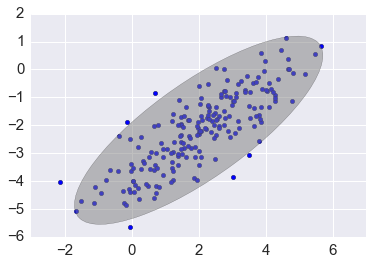
Gaussian Mixture Model¶
In [58]:
from theano.compile.ops import as_op
import theano.tensor as T
In [59]:
np.random.seed(1)
y = np.r_[np.random.normal(-6, 2, 500),
np.random.normal(0, 1, 200),
np.random.normal(4, 1, 300)]
n = y.shape[0]
In [60]:
plt.hist(y, bins=20, normed=True, alpha=0.5)
pass
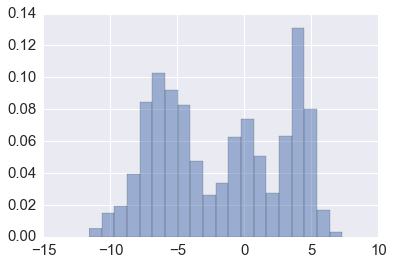
In [61]:
@as_op(itypes=[T.dvector, T.lvector], otypes=[T.dvector])
def mu_k(mu, z):
return mu[z]
@as_op(itypes=[T.dvector, T.lvector], otypes=[T.dvector])
def sigma_k(sigma, z):
return sigma[z]
In [62]:
k = 3
niter = 10000
with pm.Model() as gmm:
p = pm.Dirichlet('p', np.array([1]*k), testval=np.ones(k)/k)
z = pm.Categorical('z', p=p, shape=n)
mu0 = pm.Normal('mu0', mu=0, sd=5*y.std(), shape=k)
sd0 = pm.HalfCauchy('sd0', beta=1, shape=k)
mu = pm.Normal('mu', mu=mu0, sd=sd0, shape=k)
sigma = pm.HalfCauchy('sigma', beta=1, shape=k)
Y_obs = pm.Normal('Y_obs', mu=mu_k(mu, z), sd=sigma_k(sigma, z), observed=y)
step1 = pm.ElemwiseCategoricalStep(vars=[z], values=range(k))
step2 = pm.Metropolis(vars=[p, mu0, sd0, mu, sigma])
trace = pm.sample(niter, step=[step1, step2])
Applied stickbreaking-transform to p and added transformed p_stickbreaking to model.
Applied log-transform to sd0 and added transformed sd0_log to model.
Applied log-transform to sigma and added transformed sigma_log to model.
[-----------------100%-----------------] 10000 of 10000 complete in 289.2 sec
In [63]:
burn = niter//2
trace = trace[burn:]
pm.traceplot(trace, varnames=['p', 'mu', 'sigma'])
pass
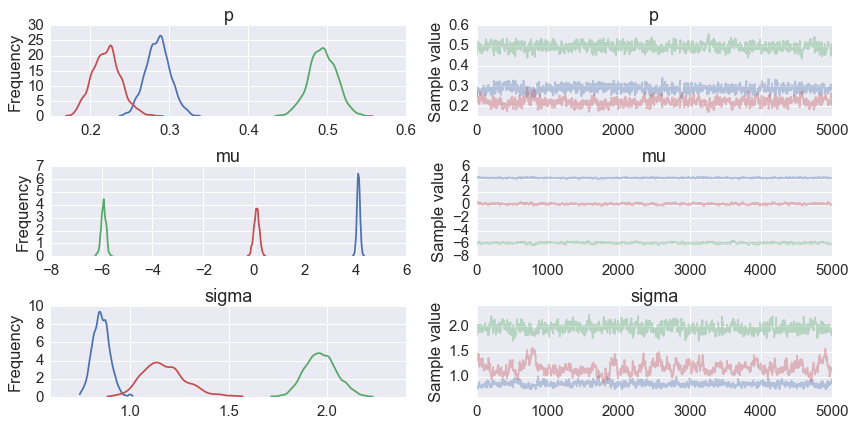
Changepoint detection¶
In [64]:
early = 10
late = 12
y = np.r_[np.random.poisson(early, 25), np.random.poisson(late, 75)]
In [65]:
niter = 10000
t = range(len(y))
with pm.Model() as change_point:
cp = pm.DiscreteUniform('change_point', lower=0, upper=len(y), testval=len(y)//2)
mu0 = pm.Exponential('mu0', 1/y.mean())
mu1 = pm.Exponential('mu1', 1/y.mean())
mu = T.switch(t < cp, mu0, mu1)
Y_obs = pm.Poisson('Y_obs', mu=mu, observed=y)
trace = pm.sample(niter)
Applied log-transform to mu0 and added transformed mu0_log to model.
Applied log-transform to mu1 and added transformed mu1_log to model.
Assigned Metropolis to change_point
Assigned NUTS to mu0_log
Assigned NUTS to mu1_log
[-----------------100%-----------------] 10000 of 10000 complete in 8.8 sec
In [66]:
pm.traceplot(trace, varnames=['change_point', 'mu0', 'mu1'])
pass

Bandits¶
One-arm bandit refers to slot machines in a casino. The multi-arm bandit problem is that you are faced with multiple slot machines, and they each have potentially different payoffs - perhaps there is one machine where you could potentially win a lot of money and others where you would lose money in the long run. You need to balance exploration (trying different machines) against exploitation (sticking to the best machine found so far) in an optimal way to maximize your gains. Suppose you were looking for a mate among N candidates - how do you optimize your dating strategy as a good Bayesian?
Adapted from Bayesian Methods for Hackers
In [67]:
k = 6
bandits = np.random.uniform(0, 1, k)
a = np.ones(k)
b = np.ones(k)
wins = np.zeros(k)
trials = np.zeros(k)
dist = stats.beta(a, b)
n = 1000
dists = [dist]
for _ in range(n-1):
i = np.argmax(dist.rvs())
print(i, end=', ')
payoff = np.random.rand() < bandits[i]
wins[i] += payoff
trials[i] += 1
dist = stats.beta(a + wins, b + trials - wins)
dists.append(dist)
plt.figure(figsize=(4*3, 5*2))
x = np.repeat(np.linspace(0, 1, 100), k).reshape(-1,k)
for i, dist in enumerate(dists[::(n//20)], 1):
plt.subplot(20//4,4,i)
plt.plot(x, dist.pdf(x))
if i==1: plt.legend(range(k))
plt.yticks([])
plt.xticks([])
plt.tight_layout()
0, 4, 1, 4, 5, 2, 1, 3, 3, 1, 5, 3, 2, 2, 2, 5, 0, 0, 0, 0, 0, 2, 4, 2, 2, 3, 2, 3, 2, 2, 1, 2, 1, 1, 1, 1, 4, 3, 2, 4, 2, 2, 1, 2, 2, 2, 2, 2, 4, 2, 2, 4, 4, 4, 4, 4, 4, 4, 2, 4, 2, 2, 2, 2, 4, 4, 2, 2, 2, 1, 2, 2, 2, 2, 2, 5, 2, 2, 2, 2, 2, 2, 2, 2, 2, 2, 2, 2, 2, 2, 2, 2, 2, 2, 2, 2, 2, 2, 4, 2, 2, 2, 2, 2, 2, 2, 2, 4, 2, 2, 2, 2, 2, 2, 2, 2, 2, 2, 2, 2, 2, 2, 2, 2, 2, 2, 2, 2, 2, 2, 2, 2, 2, 2, 2, 2, 2, 2, 2, 2, 2, 2, 2, 2, 2, 2, 2, 2, 2, 2, 2, 4, 2, 2, 1, 2, 2, 2, 2, 2, 2, 2, 2, 2, 2, 2, 2, 2, 2, 2, 2, 2, 2, 2, 2, 2, 2, 2, 2, 2, 2, 2, 2, 2, 2, 2, 2, 2, 2, 2, 2, 2, 2, 2, 2, 2, 2, 2, 2, 2, 2, 2, 2, 2, 2, 2, 2, 2, 2, 2, 2, 2, 2, 2, 2, 2, 2, 2, 2, 2, 2, 2, 2, 2, 2, 2, 2, 2, 2, 2, 2, 2, 2, 2, 2, 2, 2, 2, 2, 2, 2, 2, 2, 2, 2, 2, 2, 2, 2, 2, 2, 2, 2, 4, 2, 3, 2, 2, 2, 2, 2, 2, 2, 2, 2, 2, 2, 2, 2, 2, 2, 2, 2, 2, 2, 2, 2, 2, 2, 2, 2, 2, 2, 2, 2, 2, 2, 2, 2, 2, 2, 2, 2, 2, 2, 2, 2, 2, 2, 2, 2, 2, 2, 2, 2, 2, 2, 2, 2, 2, 2, 2, 2, 2, 2, 2, 2, 2, 2, 2, 2, 2, 2, 2, 2, 2, 2, 2, 2, 2, 2, 2, 2, 2, 2, 2, 2, 2, 2, 2, 2, 2, 2, 2, 2, 2, 2, 3, 2, 2, 2, 2, 2, 2, 2, 2, 2, 2, 2, 2, 2, 2, 2, 2, 2, 2, 2, 1, 2, 2, 2, 2, 2, 2, 2, 2, 2, 2, 2, 4, 2, 2, 2, 2, 2, 2, 2, 2, 2, 2, 2, 2, 2, 2, 2, 2, 2, 2, 2, 2, 2, 2, 2, 2, 2, 2, 2, 2, 2, 2, 2, 2, 2, 2, 2, 2, 2, 2, 2, 3, 2, 2, 2, 2, 2, 2, 2, 2, 2, 2, 2, 2, 2, 2, 2, 2, 2, 2, 4, 2, 2, 2, 4, 4, 2, 2, 2, 2, 2, 2, 2, 2, 4, 2, 2, 2, 2, 2, 2, 2, 2, 2, 2, 2, 2, 2, 2, 2, 2, 2, 2, 2, 2, 4, 2, 4, 2, 2, 4, 2, 2, 2, 2, 2, 2, 2, 2, 4, 2, 2, 2, 2, 4, 2, 2, 4, 2, 2, 2, 4, 1, 4, 2, 2, 2, 2, 4, 4, 4, 2, 4, 2, 4, 2, 4, 1, 2, 4, 2, 2, 2, 2, 4, 2, 2, 2, 2, 2, 2, 4, 4, 2, 2, 1, 2, 2, 4, 2, 2, 2, 2, 2, 4, 2, 4, 4, 4, 4, 4, 2, 2, 4, 4, 4, 4, 4, 4, 4, 4, 4, 4, 4, 4, 2, 4, 4, 4, 4, 2, 2, 4, 4, 4, 4, 4, 4, 4, 4, 2, 4, 4, 4, 4, 4, 4, 4, 4, 4, 4, 4, 4, 4, 4, 4, 4, 4, 4, 2, 4, 4, 4, 4, 4, 4, 4, 4, 4, 2, 4, 4, 4, 4, 4, 4, 4, 4, 4, 4, 4, 4, 4, 4, 4, 4, 4, 4, 4, 4, 4, 2, 4, 4, 4, 4, 4, 5, 4, 4, 4, 4, 2, 4, 4, 4, 4, 4, 4, 4, 4, 4, 4, 4, 4, 4, 2, 2, 4, 4, 4, 4, 4, 4, 2, 4, 4, 4, 1, 4, 4, 4, 2, 4, 4, 2, 4, 4, 4, 4, 4, 4, 4, 4, 4, 4, 2, 4, 4, 4, 4, 4, 4, 4, 4, 4, 4, 4, 4, 4, 4, 4, 2, 4, 4, 4, 4, 4, 4, 2, 4, 4, 4, 4, 4, 4, 4, 4, 4, 2, 4, 4, 4, 4, 4, 4, 4, 4, 4, 4, 4, 4, 4, 2, 4, 4, 4, 4, 4, 4, 4, 4, 4, 4, 4, 4, 4, 4, 4, 4, 4, 4, 4, 4, 4, 4, 2, 4, 4, 4, 0, 4, 4, 4, 4, 4, 4, 4, 4, 4, 4, 4, 4, 4, 4, 4, 4, 4, 4, 4, 4, 4, 4, 4, 4, 4, 4, 4, 4, 4, 4, 4, 4, 4, 4, 4, 4, 4, 4, 4, 4, 4, 4, 4, 4, 4, 4, 4, 4, 4, 4, 4, 4, 4, 4, 4, 4, 4, 2, 2, 4, 4, 4, 4, 4, 4, 4, 2, 4, 4, 4, 4, 4, 4, 4, 4, 4, 4, 4, 4, 4, 4, 4, 4, 4, 4, 4, 4, 4, 4, 4, 4, 4, 4, 4, 4, 4, 4, 2, 4, 4, 2, 4, 4, 4, 4, 4, 4, 4, 4, 4, 4, 4, 4, 4, 4, 4, 4, 4, 4, 4, 4, 4, 2, 4, 4, 4, 4, 4, 2, 4, 4, 4, 4, 4, 4, 4, 4, 4, 2, 4, 4, 2, 2, 2, 2, 4, 4, 4, 4, 4, 4, 4, 4, 4, 4, 4, 4, 4, 2, 4, 4, 4, 4, 4, 4, 4, 4, 4, 4, 4, 4, 4, 4, 2, 4, 4, 4, 4, 4, 4, 4, 4, 4, 4, 4, 4, 4, 4, 4, 4, 4, 4, 2, 4, 4, 4, 4, 4, 4, 4, 4, 4, 4, 4, 4, 4, 4, 2, 4, 4, 4, 4, 4, 2, 4, 4, 4, 4, 4, 4, 4, 2, 4, 4, 4, 4, 4, 4, 4, 4, 4, 4, 4, 4, 4, 4, 2, 4, 4, 4,
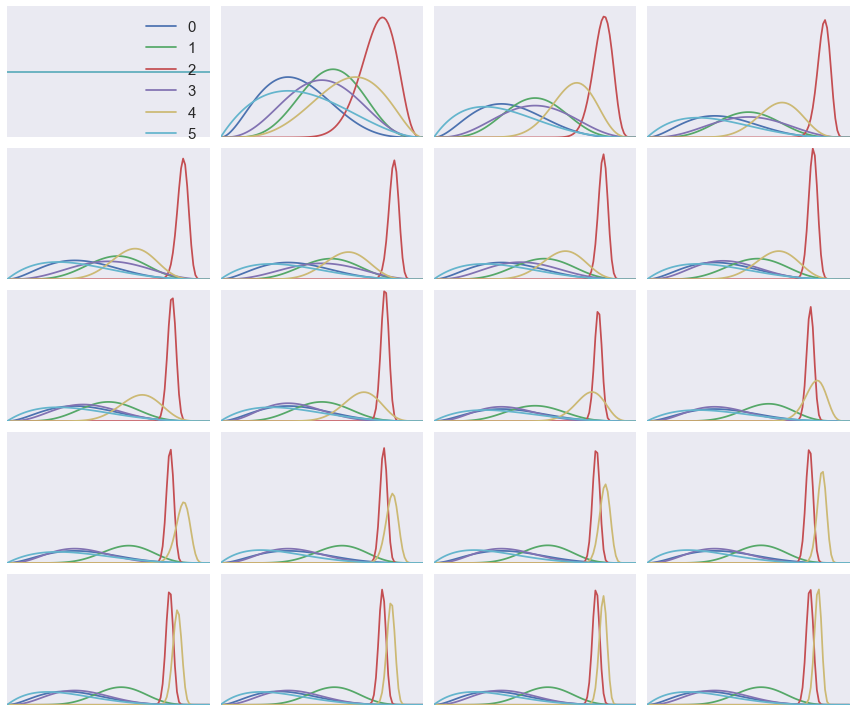
In [68]:
np.set_printoptions(formatter={'all': lambda x: '%5.2f' % x})
bandits
Out[68]:
array([ 0.04, 0.74, 0.76, 0.18, 0.85, 0.28])
In [69]:
%load_ext version_information
%version_information numpy, scipy, matplotlib, seaborn, pymc3
Out[69]:
| Software | Version |
|---|---|
| Python | 3.5.1 64bit [GCC 4.2.1 (Apple Inc. build 5577)] |
| IPython | 4.1.2 |
| OS | Darwin 15.3.0 x86_64 i386 64bit |
| numpy | 1.10.4 |
| scipy | 0.17.0 |
| matplotlib | 1.5.1 |
| seaborn | 0.7.0 |
| pymc3 | 3.0 |
| Fri Mar 11 11:37:14 2016 EST | |
In [ ]:

